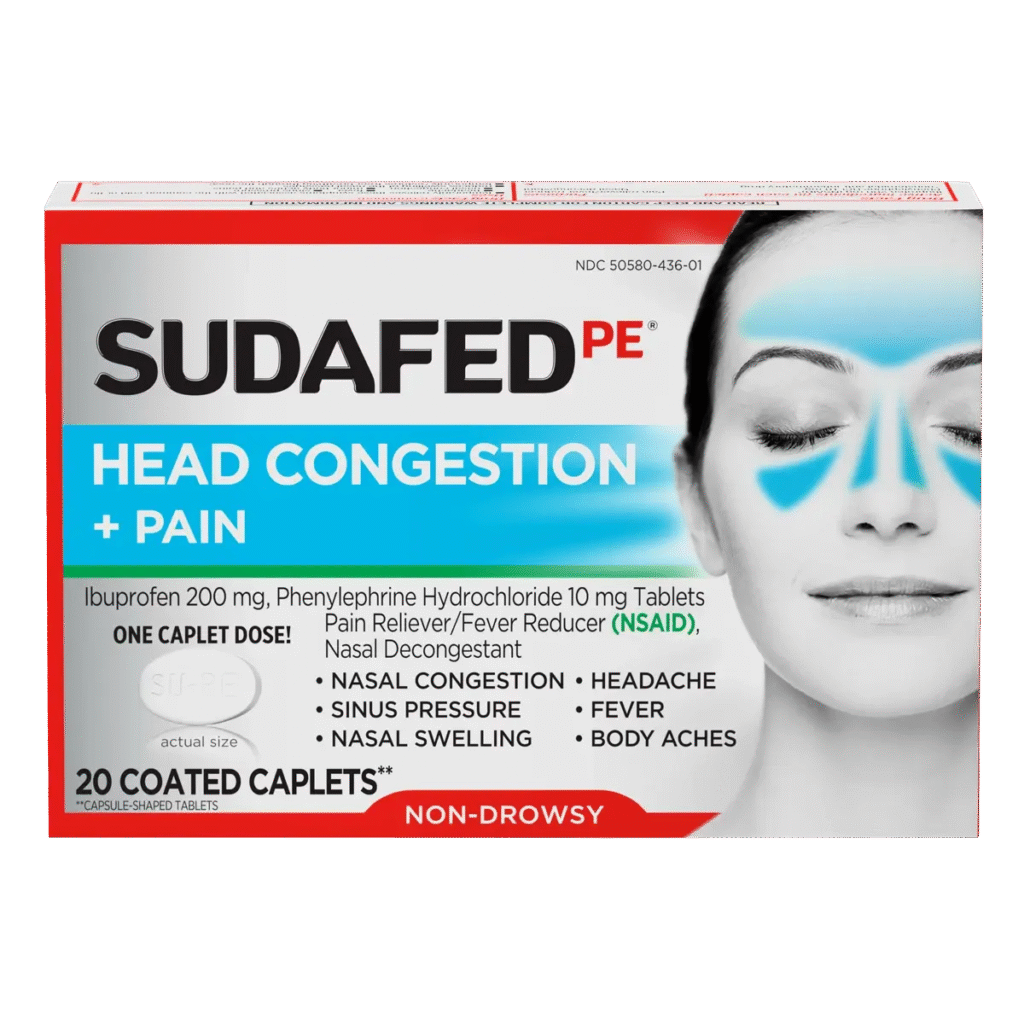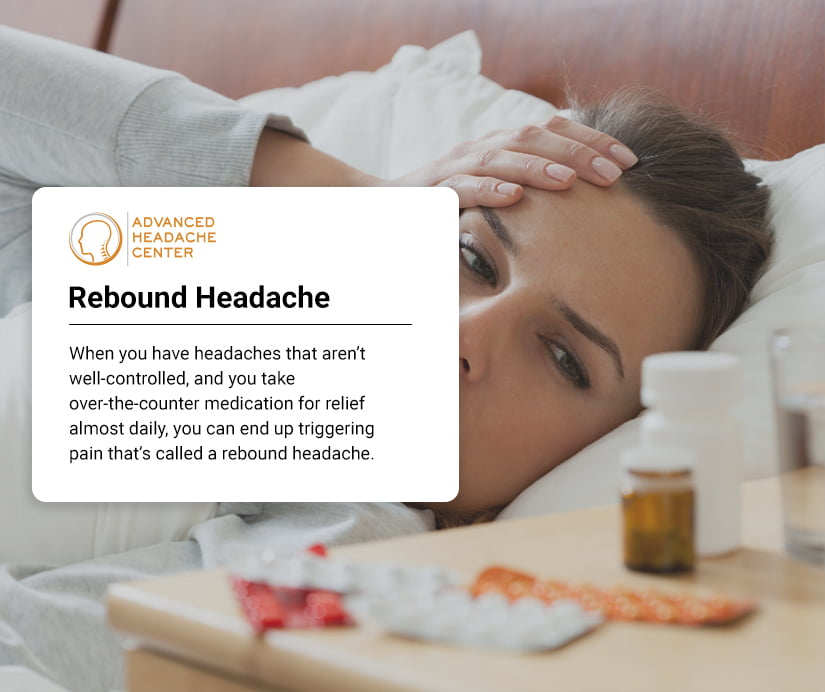When that throbbing headache hits alongside stubborn nasal congestion, you’re likely wondering: what can I take with Sudafed for a headache to feel better fast? The good news is that Sudafed (pseudoephedrine) — a trusted decongestant — can be safely paired with certain over-the-counter pain relievers to ease both pressure and pain. But not every combination is right for everyone. Knowing which medications work synergistically with Sudafed, and which to avoid, is key to staying safe while getting real relief. Keep reading to discover the best options, expert-backed tips, and recommended products to help you breathe easier and feel better today.
Experience expert medication consultation and safe pain relief guidance at Smile Pharmacy, where your health and medication safety are our highest priorities.

Understanding Sudafed and Its Effects on Headaches
Sudafed contains pseudoephedrine hydrochloride, a sympathomimetic decongestant that works by constricting blood vessels in nasal passages to reduce swelling and congestion. While primarily designed for nasal congestion relief, Sudafed can indirectly help with certain types of headaches, particularly those caused by sinus pressure and congestion. However, it’s important to note that pseudoephedrine can sometimes trigger headaches in sensitive individuals due to its stimulating effects on the cardiovascular system.
How Sudafed Affects Your Body:
- Vasoconstriction: Narrows blood vessels to reduce nasal swelling
- Stimulant Properties: Can increase heart rate and blood pressure
- Sinus Pressure Relief: Reduces congestion that may contribute to headache pain
- Duration of Action: Immediate-release forms last 4-6 hours, extended-release up to 12 hours
Research demonstrates that pseudoephedrine combinations with pain relievers provide superior relief for upper respiratory symptoms compared to using either medication alone. This synergistic effect makes combination therapy particularly valuable for managing both congestion and headache pain simultaneously.
What can i take with sudafed for a headache? Safe Pain Relievers
Multiple over-the-counter pain relievers can be safely combined with Sudafed to provide comprehensive headache and congestion relief. Understanding the safety profile and optimal dosing for each combination ensures effective symptom management without dangerous side effects.
Acetaminophen (Tylenol) with Sudafed
Safety Profile: Acetaminophen is considered the safest pain reliever to combine with Sudafed, with no documented drug interactions between these medications. This combination is so well-established that numerous FDA-approved over-the-counter products contain both ingredients together.
Clinical Evidence: Studies involving over 300 patients demonstrate that paracetamol (acetaminophen) combined with pseudoephedrine provides superior pain relief and decongestant effects compared to either medication used alone.
Dosing Guidelines:
- Acetaminophen: 500-1000 mg every 4-6 hours (maximum 3,000-4,000 mg per 24 hours)
- Sudafed: 30-60 mg every 4-6 hours (maximum 240 mg per 24 hours)
- Timing: Can be taken simultaneously or on alternating schedules
Benefits of This Combination:
- Proven safety record with extensive clinical testing
- Available in pre-formulated combination products
- Works through different mechanisms for comprehensive relief
- Suitable for most adults and adolescents over 12 years
Ibuprofen (Advil, Motrin) with Sudafed

Safety Assessment: Ibuprofen can be safely combined with Sudafed, as confirmed by multiple drug interaction databases showing no significant interactions. Several prescription and over-the-counter combination products contain both ibuprofen and pseudoephedrine, demonstrating their established safety profile.
Clinical Advantages: Ibuprofen’s anti-inflammatory properties may provide superior relief for sinus-related headaches compared to acetaminophen, particularly when inflammation contributes to pain and pressure.smilerxnj
Optimal Dosing:
- Ibuprofen: 200-400 mg every 6-8 hours (maximum 1,200 mg per 24 hours for OTC use)
- Sudafed: Standard dosing as above
- Food Requirement: Take ibuprofen with food to minimize stomach irritation
Special Considerations:
- Monitor for stomach upset, especially with prolonged use
- May provide better anti-inflammatory effects for sinus headaches
- Consider alternating with acetaminophen for extended relief periods
Transform your headache management with expert pharmaceutical guidance from Smile Pharmacy where medication safety meets effective symptom relief.
Additional Safe Combinations
Naproxen (Aleve) with Sudafed
Safety Profile: Naproxen can be safely combined with Sudafed and is available in FDA-approved combination products specifically formulated for sinus pressure and headache relief.
Advantages: Longer duration of action (8-12 hours) compared to ibuprofen, potentially reducing dosing frequency while maintaining effective symptom control.
Dosing Information: Combination products typically contain 220 mg naproxen with 120 mg pseudoephedrine, taken every 12 hours as directed.
Aspirin with Sudafed
Clinical Evidence: Research involving 833 patients demonstrates that aspirin combined with pseudoephedrine provides safe and effective relief for upper respiratory tract symptoms, including headache and nasal congestion.
Safety Considerations:
- Avoid in children under 16 due to Reye’s syndrome risk
- Consider stomach protection with prolonged use
- Follow standard aspirin dosing guidelines
Medication Combinations to Avoid

Understanding which medications should never be combined with Sudafed is crucial for preventing dangerous interactions and serious health complications.
Dangerous Drug Interactions
Never Combine Sudafed With:
| Medication Class | Examples | Potential Consequences |
|---|---|---|
| MAO Inhibitors | Phenelzine, Selegiline | Hypertensive crisis, stroke risk |
| Tricyclic Antidepressants | Amitriptyline, Nortriptyline | High blood pressure, irregular heartbeat |
| Ergot Derivatives | Ergotamine, Dihydroergotamine | Dangerous blood pressure elevation |
| Other Stimulants | Phentermine, ADHD medications | Excessive stimulation, cardiovascular stress |
Medication Monitoring Required
Use with Caution:
- Blood Pressure Medications: Sudafed may counteract antihypertensive effects
- Digoxin: Potential for increased heart rhythm abnormalities
- Caffeine: Enhanced stimulant effects, increased blood pressure and heart rate
Optimal Dosing Strategies and Timing
Maximum Daily Limits
Safe Daily Dosage Guidelines:
| Medication | Maximum Daily Dose (Adults) | Dosing Interval | Special Notes |
|---|---|---|---|
| Pseudoephedrine | 240 mg | Every 4-6 hours | Take last dose 6+ hours before bedtime |
| Acetaminophen | 3,000-4,000 mg | Every 4-6 hours | Check for hidden sources in other medications |
| Ibuprofen (OTC) | 1,200 mg | Every 6-8 hours | Take with food to prevent stomach upset |
| Naproxen | Follow package directions | Every 8-12 hours | Longer-acting than other NSAIDs |
| Aspirin | Follow package directions | Every 4-6 hours | Avoid in children under 16 |
Timing Optimization Strategies
Simultaneous Dosing: Most pain relievers can be taken at the same time as Sudafed for immediate relief of both headache and congestion.
Alternating Schedule: For extended symptom control, consider alternating acetaminophen and ibuprofen every 3-4 hours while maintaining the Sudafed schedule.
Sleep Considerations: Take the last Sudafed dose several hours before bedtime to prevent insomnia, while continuing pain relievers as needed for overnight comfort.
Special Populations and Safety Considerations

High Blood Pressure Patients
Critical Warning: Individuals with uncontrolled high blood pressure should avoid Sudafed or use it only under medical supervision, as pseudoephedrine can significantly elevate blood pressure.
Alternative Options: Consider decongestant-free medications like Coricidin HBP, which are specifically formulated for people with hypertension.
Pregnancy and Breastfeeding
Safety Profile: Sudafed is generally considered safe during pregnancy when used as directed, but consult with healthcare providers before combining with pain relievers.
Breastfeeding Considerations: Small amounts may pass into breast milk, potentially affecting infant sleep patterns.
Elderly Patients
Enhanced Sensitivity: Older adults may experience increased sensitivity to stimulant effects, requiring dose modifications or closer monitoring.
Drug Interaction Risk: Higher likelihood of taking multiple medications that could interact with Sudafed combinations.
Signs of Adverse Reactions and When to Seek Help
Emergency Warning Signs
Seek Immediate Medical Attention for:
- Severe, sudden headache or changes in headache pattern
- Chest pain or difficulty breathing
- Fast, irregular, or pounding heartbeat
- Confusion, dizziness, or seizures
- Signs of allergic reaction (rash, swelling, difficulty breathing)
- Severe stomach pain or blood in vomit/stool
Medication Overdose Symptoms
Acetaminophen Overdose Warning Signs:
- Nausea, vomiting, loss of appetite
- Stomach pain and excessive sweating
- Dark urine or yellowing of skin/eyes
- Confusion or unusual weakness
Ibuprofen Overdose Indicators:
- Severe stomach pain or blood in vomit
- Black, tarry stools
- Ringing in ears or hearing changes
- Unusual heart rate changes or difficulty breathing
Experience comprehensive medication safety monitoring and expert consultation at Smile Pharmacy where your health outcomes and medication interactions are carefully managed.
Alternative Non-Medication Approaches
Complementary Headache Relief Methods
Physical Approaches:
- Cold or warm compresses applied to head, neck, or sinuses
- Gentle massage of temples, neck, and shoulder muscles
- Adequate hydration with water and clear fluids
- Rest in quiet, darkened environment to reduce sensory stimulation
Sinus Pressure Relief:
- Saline nasal rinses using neti pots or saline sprays
- Steam inhalation from hot showers or humidifiers
- Elevation of head during sleep to promote drainage
- Gentle sinus massage to encourage congestion clearance
Lifestyle Modifications
Prevention Strategies:
- Maintain consistent sleep schedules
- Stay adequately hydrated throughout the day
- Limit alcohol and caffeine consumption
- Practice stress reduction techniques
- Avoid known headache triggers when possible
Hidden Ingredient Awareness
Reading Labels Carefully
Common Products Containing Acetaminophen:
- DayQuil, NyQuil, and other cold medications
- Excedrin products (contains acetaminophen, aspirin, and caffeine)
- Many prescription pain medications
- Some sleep aids and allergy medications
Products Often Containing NSAIDs:
- Multi-symptom cold and flu remedies
- Menstrual relief medications
- Some topical pain relief products
- Prescription combination medications
Critical Safety Tip: Always read medication labels completely to avoid accidental overdoses when combining multiple products containing the same active ingredients.
Best Practices for Safe Medication Use
Documentation and Tracking
Maintain Medication Records:
- Keep detailed logs of all medications taken, including timing and dosages
- Note any adverse reactions or unusual symptoms
- Track effectiveness of different combination strategies
- Share complete medication lists with all healthcare providers
Professional Consultation Guidelines
When to Consult Healthcare Providers:
- Before starting any new medication combinations
- If headaches worsen or change in character
- When current treatments become less effective
- For recurring headaches requiring frequent medication use
- When managing multiple health conditions simultaneously
Pharmacist Consultation Benefits:
- Expert knowledge of drug interactions and safety
- Personalized recommendations based on your specific situation
- Access to professional drug interaction screening tools
- Guidance on optimal timing and dosing strategies
Frequently Asked Questions
Q: Can I take Tylenol and Sudafed together for a headache?
A: Yes, acetaminophen (Tylenol) can be safely taken with Sudafed. These medications have no documented interactions and are available together in FDA-approved combination products. This is considered one of the safest combinations for treating headache and congestion simultaneously.
Q: Is it safe to take ibuprofen with Sudafed for sinus headache?
A: Yes, ibuprofen can be safely combined with Sudafed. This combination may be particularly effective for sinus headaches due to ibuprofen’s anti-inflammatory properties. Take ibuprofen with food to minimize stomach irritation.
Q: How long can I safely use Sudafed with pain relievers?
A: For over-the-counter use, limit Sudafed to 7 days maximum. Pain relievers should be used according to package directions, typically not exceeding 10 days for pain relief. Consult a healthcare provider if symptoms persist beyond these timeframes.
Q: What should I avoid while taking Sudafed for headaches?
A: Avoid alcohol, excessive caffeine, and other stimulant medications. Never combine with MAO inhibitors, tricyclic antidepressants, or ergot medications. Limit caffeine intake as it can enhance stimulant effects and potentially worsen headaches.
Q: Can I alternate different pain relievers with Sudafed?.
A: Yes, you can safely alternate acetaminophen and ibuprofen every 3-4 hours while maintaining your Sudafed schedule. This approach can provide better around-the-clock pain relief than using either pain reliever alone.
Q: What if my headache gets worse after taking Sudafed?
A: Discontinue use and consult a healthcare provider. Some people experience headaches as a side effect of pseudoephedrine due to its stimulant effects on blood pressure and heart rate. Alternative decongestants may be more appropriate.
Q: Are there any natural alternatives to combine with Sudafed?
A: While Sudafed should only be combined with proven safe medications, you can use non-medication approaches like saline rinses, steam inhalation, cold/warm compresses, and adequate hydration alongside your medication regimen.
Q: Should people with high blood pressure avoid these combinations?
A: People with uncontrolled high blood pressure should avoid Sudafed entirely, as it can significantly elevate blood pressure. Consult your healthcare provider about safer alternatives like Coricidin HBP products specifically designed for hypertensive patients.
Transform your headache and congestion management with expert pharmaceutical consultation at Smile Pharmacy. Our experienced pharmacists provide personalized medication safety guidance, ensuring optimal symptom relief while maintaining your health and safety through professional drug interaction screening and comprehensive care.